A Novel Hybrid Approach for Water Resources Carrying Capacity Assessment by Integrating Fuzzy Comprehensive Evaluation and Analytical Hierarchy Process Methods with the Cloud Model
Abstract
1. Introduction
2. Methodology
2.1. The Establishment Method of an Indicator-Based System for WRCCA
2.1.1. Selection of the Evaluation Indicator
- (1)
- Determine the reference sequence
- (2)
- Determine the comparison sequence
- (3)
- Normalization of data sequence
- (4)
- Calculate the absolute difference
- (5)
- Calculate the gray correlation coefficient
- (6)
- Calculate the gray correlation degree
- (7)
- Sort the gray correlation degrees
2.1.2. Determination of the Evaluation Indicator Criteria
- (1)
- The length ( of the data sequence interval is calculated as:where and are the maximum and minimum of indicator in the data series, respectively.
- (2)
- The average interval () of the data series is calculated as:
- (3)
- Calculate the upper and lower limits of each level to obtain its interval; the -th level can be expressed as:By using this method, the level standards of each evaluation indicator can be obtained.
2.2. The Theory of FCE-AHP-CM Hybrid Approach for WRCCA
2.2.1. The Fuzzy Comprehensive Evaluation (FCE) Method for WRCCA
- (1)
- The determination of evaluation index set
- (2)
- The determination of evaluation level set
- (3)
- The weights calculation of subsystem and evaluation indicator
- (4)
- The calculation of membership degree
- (5)
- The calculation of comprehensive evaluation set
2.2.2. The Integration of FCE and AHP Methods for WRCCA
- (1)
- The determination of relative importance between subsystems and evaluation indicators
- (2)
- The construction of judgement matrix
- (3)
- The consistency test of judgement matrix
- (4)
- The calculation of weights
2.2.3. The Integration of AHP and FCE Methods with the Cloud Model for WRCCA
- (1)
- The definition of a cloud
- (2)
- Normal cloud model
- (3)
- The algebraic operation of the cloud
2.3. The Integration Method of FCE-AHP-CM Hybrid Approach for WRCCA
2.3.1. The Integration Method of AHP with the Cloud Model for WRCCA
- (1)
- The relative importance’s of indicators scaled with the eigenvalues of the cloud model
- (2)
- The aggregation of judgement matrices described by the floating cloud model
- (3)
- The weights of subsystems and indicators expressed with cloud models
2.3.2. The Integration Method of FCE with the Cloud Model for WRCCA
- (1)
- The different levels of comment sets described with the eigenvalues of cloud models
- (2)
- The membership degree matrix calculated by the forward cloud generator
- (3)
- The comprehensive evaluation sets calculated by cloud operations
2.3.3. The Results of WRCCA Described with Evaluation Index Clouds
- (1)
- Division of the WRCC levels
- (2)
- The assignment clouds of WRCC levels determined by golden section cloud generation
- (3)
- The WRCCA index clouds calculated by cloud operations
3. Application
3.1. Study Area
3.2. Evaluation Indicator System Construction and Data Preparation for WRCCA in the Study Area
3.3. Results of WRCCA in the Study Area
3.3.1. Calculation of the Weights Clouds for Subsystems and Indicators
3.3.2. Calculation of the Membership Matrices and Comprehensive Evaluation Sets of Subsystems
3.3.3. Calculation of the Evaluation Index Clouds for WRCCA in the Study Area
3.3.4. Determination of the Evaluation Levels for WRCCA in the Study Area
3.4. Validation and Analysis of WRCCA in the Study Area
3.4.1. WRCCA Results Validation in the Study Area
3.4.2. Mechanism Analyses of the WRCC Changes in the Study Area Based on the Evaluation Index
4. Conclusions
Author Contributions
Funding
Acknowledgments
Conflicts of Interest
References
- Rijsberman, M.A.; Ven, F.H.M.V.D. Different approaches to assessment of design and management of sustainable urban water systems. Environ. Impact Assess. Rev. 2000, 20, 333–345. [Google Scholar] [CrossRef]
- Park, R.; Assimilation, B.E. Introduction to the Science of Sociology; University of Chicago Press: Chicago, IL, USA, 1921. [Google Scholar]
- UNESCO; FAO. Carrying Capacity Assessment with a Pilot Study of Kenya: A Resource Accounting Methodology for Sustainable Development; United Nations Educational, Scientific and Cultural Organization: Paris, France, 1985. [Google Scholar]
- National Research Council. Areview of the Florida Keys Carring Capacity Study; National Academy Press: Washington, DC, USA, 2002. [Google Scholar]
- Xinjiang Water Resources Soft Science Research Group. Strategies and countermeasures for the development of Xinjiang water resources and its carrying capacity. Water Res. Hydropower Eng. 1989, 6, 2–9. (In Chinese) [Google Scholar]
- Shi, Y.F.; Qu, Y.G. The Carrying Capacity of Water Resources and Its Reasonable Use of Urumqi River; Science Press: Beijing, China, 1992. (In Chinese) [Google Scholar]
- Xu, Y.P. A study of comprehensive evaluation of the water resource carrying capacity in the arid area—A case study in the Hetian river basin of Xinjiang. J. Nat. Res. 1993, 3, 229–237. (In Chinese) [Google Scholar]
- Feng, S.Y.; Liu, G.Q. A Holistic Framework for Sustaining Water Resources Utilization. Adv. Water Sci. 1997, 4, 2–8. (In Chinese) [Google Scholar]
- Hui, Y.H.; Jiang, X.H.; Huang, Q.; Xue, X.J. On system dynamic simulation model of water resources bearing capacity in duality mode. Geogr. Res. 2001, 2, 191–198. (In Chinese) [Google Scholar]
- Xia, J.; Zhu, Y.Z. The measurement of water resources security: A study and challenge on water resources carrying capacity. J. Nat. Res. 2002, 3, 262–269. (In Chinese) [Google Scholar]
- He, R.W.; Liu, S.Q.; Liu, Y.W. Application of system dynamics in analyzing the carrying capacity of water resources in karst region of Southwest china—A case study in Bijie region, Guizhou province. Sci. Geogr. Sin. 2011, 31, 1376–1382. [Google Scholar]
- Liu, H.Q. A study on the change trends of regional water resource carrying capacity. Lect. Notes Electr. Eng. 2012, 113, 1375–1380. [Google Scholar]
- Meng, L.H.; Chen, Y.N.; Li, W.H.; Zhao, R.F. Fuzzy comprehensive evaluation model for water resources carrying capacity in Tarim river basin, Xinjiang, China. Chin. Geogr. Sci. 2009, 19, 89–95. [Google Scholar] [CrossRef]
- Gong, L.; Jin, C.L. Fuzzy Comprehensive Evaluation for Carrying Capacity of Regional Water Resources. Water Res. Manag. 2009, 23, 2505–2513. [Google Scholar] [CrossRef]
- Gao, Y.; Zhang, S.; Xu, G.W.; Su, H.M.; Zhang, Y. Study on water resources carrying capacity in Hefei city. Adv. Mat. Res. 2012, 610–613, 2701–2704. [Google Scholar] [CrossRef]
- Liu, J.J.; Dong, S.C.; Li, Z.H. Comprehensive evaluation of china’s water resources carrying capacity. J. Nat. Res. 2011, 26, 258–269. (In Chinese) [Google Scholar]
- Guo, Q.; Wang, J.Y.; Zhang, B. Comprehensive evaluation of the water resources carrying capacity based on DPSIMR. J. Nat. Res. 2017, 32, 484–493. (In Chinese) [Google Scholar]
- Chen, Y.B.; Chen, J.H.; Li, C.X.; Feng, Z.Y. Indicators for water resources carrying capacity assessment based on driving forces-pressure-state-impact-response model. J. Hydraul. Eng. 2004, 7, 98–103. (In Chinese) [Google Scholar]
- Jin, J.L.; Shen, S.X.; Chen, M.L.; Li, J.Q.; Guo, X.N.; Chang, T. Application of genetic analytic hierarchy process in screening the evaluation index system of regional water resources carrying capacity. J. North China Univ. Water Res. Elec. Power (Nat. Sci.) 2019, 40, 1–6. (In Chinese) [Google Scholar]
- Wang, J.H.; Zhai, Z.L.; Sang, X.F.; Li, H.H. Study on index system and judgment criterion of water resources carrying capacity. J. Hydraul. Eng. 2017, 48, 1023–1029. [Google Scholar]
- Yang, Z.Y.; Song, J.X.; Cheng, D.D.; Xia, J.; Li, Q.; Ahamad, M.I. Comprehensive evaluation and scenario simulation for the water resources carrying capacity in Xi’an city, China. J. Environ. Manag. 2019, 230, 221–233. [Google Scholar] [CrossRef]
- Chi, M.B.; Zhang, D.S.; Fan, G.W.; Zhang, W.; Liu, H. Prediction of water resource carrying capacity by the analytic hierarchy process-fuzzy discrimination method in a mining area. Ecol. Indic. 2019, 96, 647–655. [Google Scholar] [CrossRef]
- Dai, D.; Sun, M.D.; Xu, X.Q.; Lei, K. Assessment of the water resource carrying capacity based on the ecological footprint: A case study in Zhangjiakou city, north china. Environ. Sci. Pollut. Res. 2019, 26, 11000–11011. [Google Scholar] [CrossRef]
- Wu, L.; Su, X.L.; Ma, X.Y.; Kang, Y.; Jiang, Y.N. Integrated modeling framework for evaluating and predicting the water resources carrying capacity in a continental river basin of northwest china. J. Clean. Prod. 2018, 204, 366–379. [Google Scholar] [CrossRef]
- Ma, L.; Zhao, J.H.; Hong, M.; Chen, L.L. Application of set pair analysis model based on entropy weight for comprehensive evaluation of water resources carrying capacity. Appl. Mech. Mater. 2012, 195–196, 764–769. [Google Scholar] [CrossRef]
- Zadeh, L.A. Fuzzy Sets. Inf. Control 1965, 8, 338–353. [Google Scholar] [CrossRef]
- Saatyt, L. The Analytical Hierarchical Process; McGraw-Hill: New York, NY, USA, 1980. [Google Scholar]
- Rodriguez, R.; Lev, B. Models, methods, concepts and applications of the analytic hierarchy process. Interfaces 2002, 32, 93. [Google Scholar]
- Saaty, T.L. The Analytic Hierarchy Process: Decision Making in Complex Environments; Springer: Boston, MA, USA, 1984. [Google Scholar]
- Vaidya, O.S.; Kumar, S. Analytic hierarchy process: An overview of applications. Eur. J. Oper. Res. 2006, 169, 1–29. [Google Scholar] [CrossRef]
- Kazakidis, V.N.; Mayer, Z.; Scoble, M.J. Decision making using the analytic hierarchy process in mining engineering. Min. Technol. 2004, 113, 30–42. [Google Scholar] [CrossRef]
- Kumar, R.; Anbalagan, R. Landslide susceptibility mapping using analytical hierarchy process (AHP) in Tehri reservoir rim region, Uttarakhand. J. Geol. Soc. India 2016, 87, 271–286. [Google Scholar] [CrossRef]
- Saaty, T.L. Erratum: “A scaling method for priorities in hierarchical structures”. Mathematical 1979, 3, 234–281. [Google Scholar]
- Li, D.Y.; Meng, H.J.; Shi, X.M. Membership clouds and membership cloud generators. Comput. Res. Dev. 1995, 6, 15–20. (In Chinese) [Google Scholar]
- Wang, S.G. Cloud model for service selection. In Proceedings of the 2011 IEEE Conference on Computer Communications Workshops, Shanghai, China, 10–15 April 2011; IEEE: Shanghai, China, 2011. [Google Scholar]
- Liang, M.; Xun, Y.; Yi, Z.X.; Fu, X.H. The qualitative forecasting model based on the cloud model and its application in macrosiphum avenae. Sci. Agric. Sin. 2002, 35, 654–659. [Google Scholar]
- Liu, D.D.; Chen, X.H.; Lou, Z.H. Analysis on characteristics of spatial-temporal precipitation distribution based on cloud model. J. Hydraul. Eng. 2009, 40, 850–857. [Google Scholar]
- Yang, S.M.; Han, X.Q.; Cao, B.; Li, B.; Yan, F. Cloud-model-based method for risk assessment of mountain torrent disasters. Water 2018, 10, 830. [Google Scholar] [CrossRef]
- Li, J.; Zhang, Q.W.; Yan, F.; Zhong, M. A cloud model-based multi-level fuzzy comprehensive evaluation approach for financing credit of scientific & technological small-medium enterprises. J. Differ. Equ. Appl. 2016, 23, 1–14. [Google Scholar]
- Wang, Z.J.; Liao, S.H.; Wu, X.F.; Zhao, J.S.; Gan, H. Water resources carrying capacity in Datong City. South North Water Transf. Water Sci. Technol. 2007, 5, 47–50. (In Chinese) [Google Scholar]
- Liu, D. Research on Regional Water Resources Carrying Capacity Assessment—A Case Study of Datong City. Master’s Thesis, North China Electric Power University, Baoding, China, March 2015. (In Chinese). [Google Scholar]
- Xi, D.C.; Xu, X.Y.; Han, D.M.; Yang, Z.W. Evaluating water resources carrying capacity in Beijing-Tianjin-Hebei region. J. Beijing Norm. Univ. (Nat. Sci.) 2017, 53, 575–581. (In Chinese) [Google Scholar]
- Wen, L.H.; Liu, H.Y.; Yao, H.J.; Zhang, G.L. Study on water resources carrying capacity in eight provinces of northern China. Res. Soil Water Conserv. 2013, 20, 168–176. (In Chinese) [Google Scholar]
- Zhang, J.R. Research on Water Resources Carrying Capacity of Beijing, Tianjin and Hebei Province Based on System Dynamics. Master’s Thesis, China University of Geosciences, Beijing, China, May 2016. (In Chinese). [Google Scholar]
- Peng, T.; Deng, H. Comprehensive evaluation on water resource carrying capacity in karst areas using cloud model with combination weighting method: A case study of Guiyang, southwest China. Environ. Sci. Pollut. Res. 2020, 27, 1–17. [Google Scholar] [CrossRef] [PubMed]
- Wu, C.G.; Zhou, L.Y.; Jin, J.L.; Ning, S.W.; Zhang, Z.X.; Bai, L. Regional water resource carrying capacity evaluation based on multi-dimensional precondition cloud and risk matrix coupling model. Sci. Total Environ. 2020, 710, 136324. [Google Scholar] [CrossRef]
- Yu, X.; Xie, J.C.; Jiang, R.G.; Zuo, G.G.; Liang, J.C. Assessment of water resource carrying capacity based on the chicken swarm optimization-projection pursuit model. Arab. J. Geosci. 2020, 13, 153–178. [Google Scholar] [CrossRef]
- Zhang, N.N. Evaluation of Water Resources Carrying Capacity of the Yellow River Basin Based on Load Balance. Master’s Thesis, Northwest A&F University, Yangling, China, May 2019. (In Chinese). [Google Scholar]
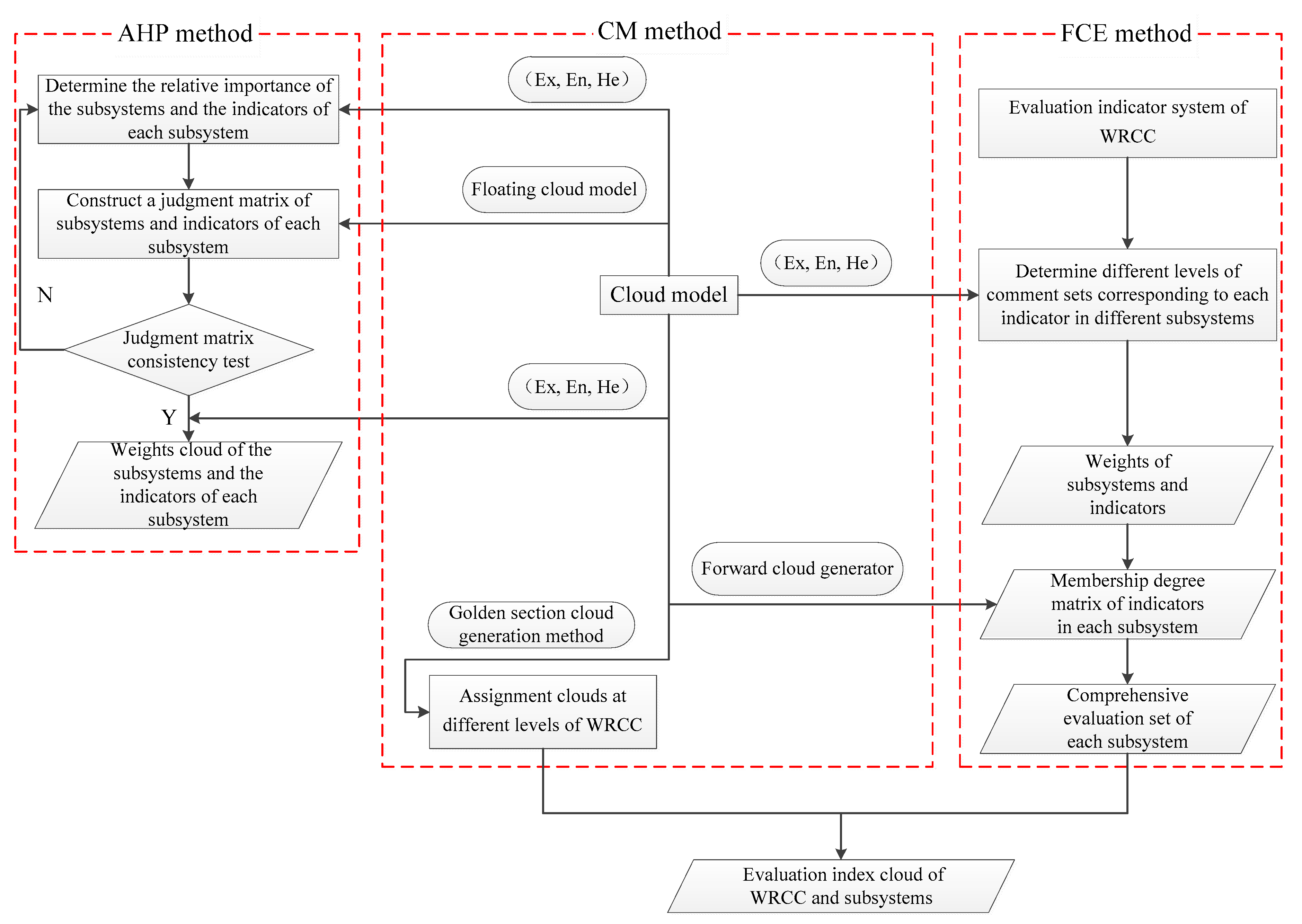
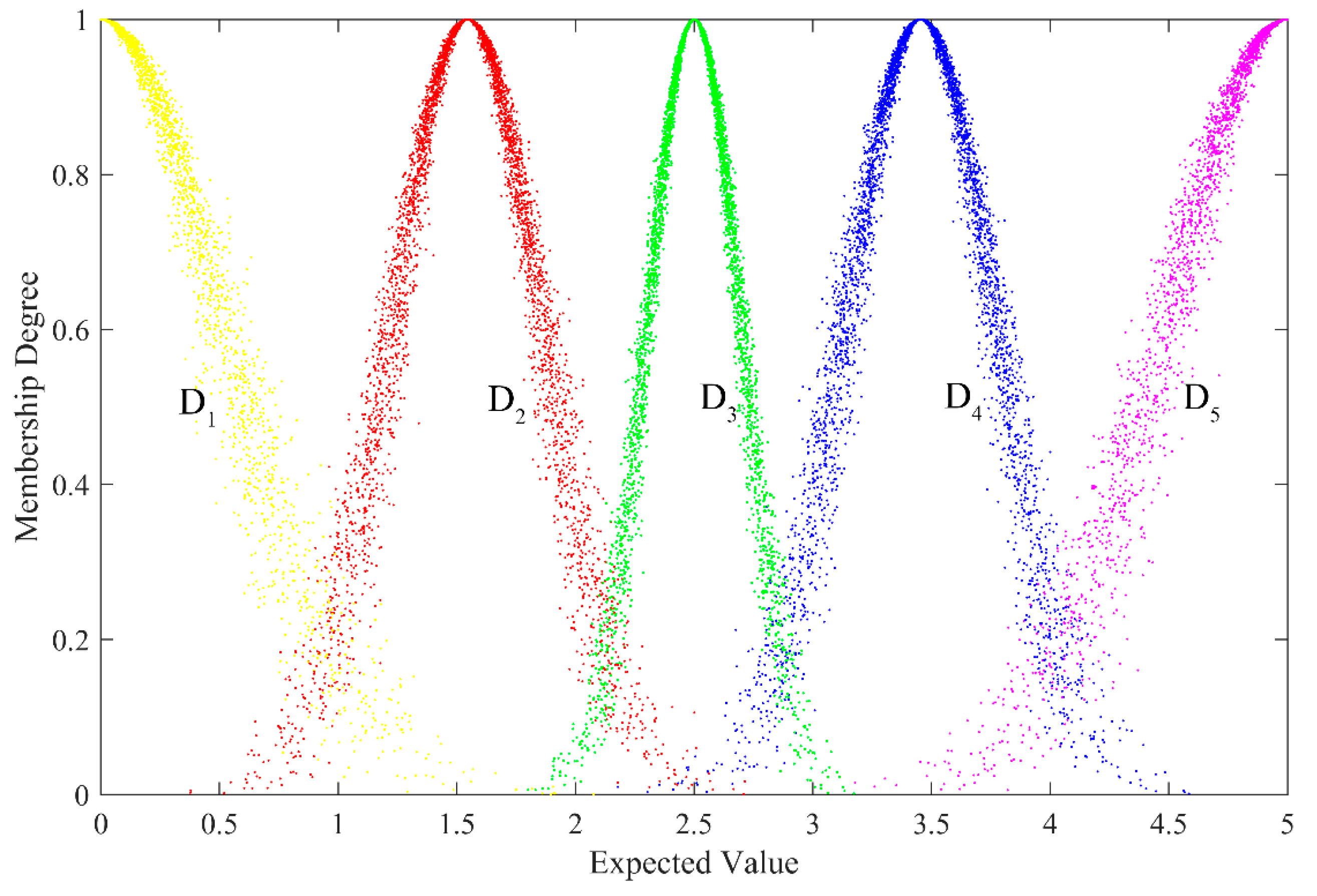
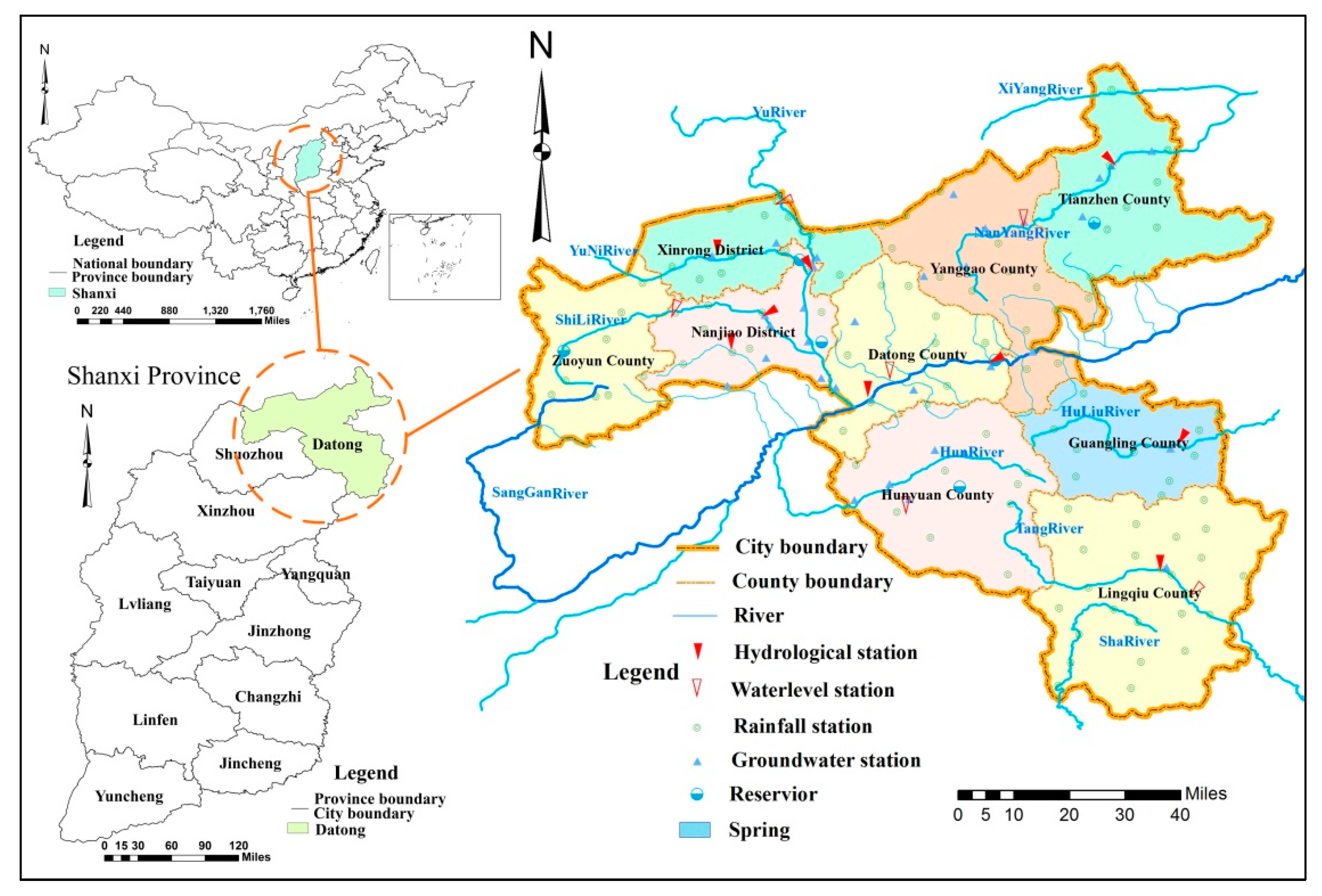
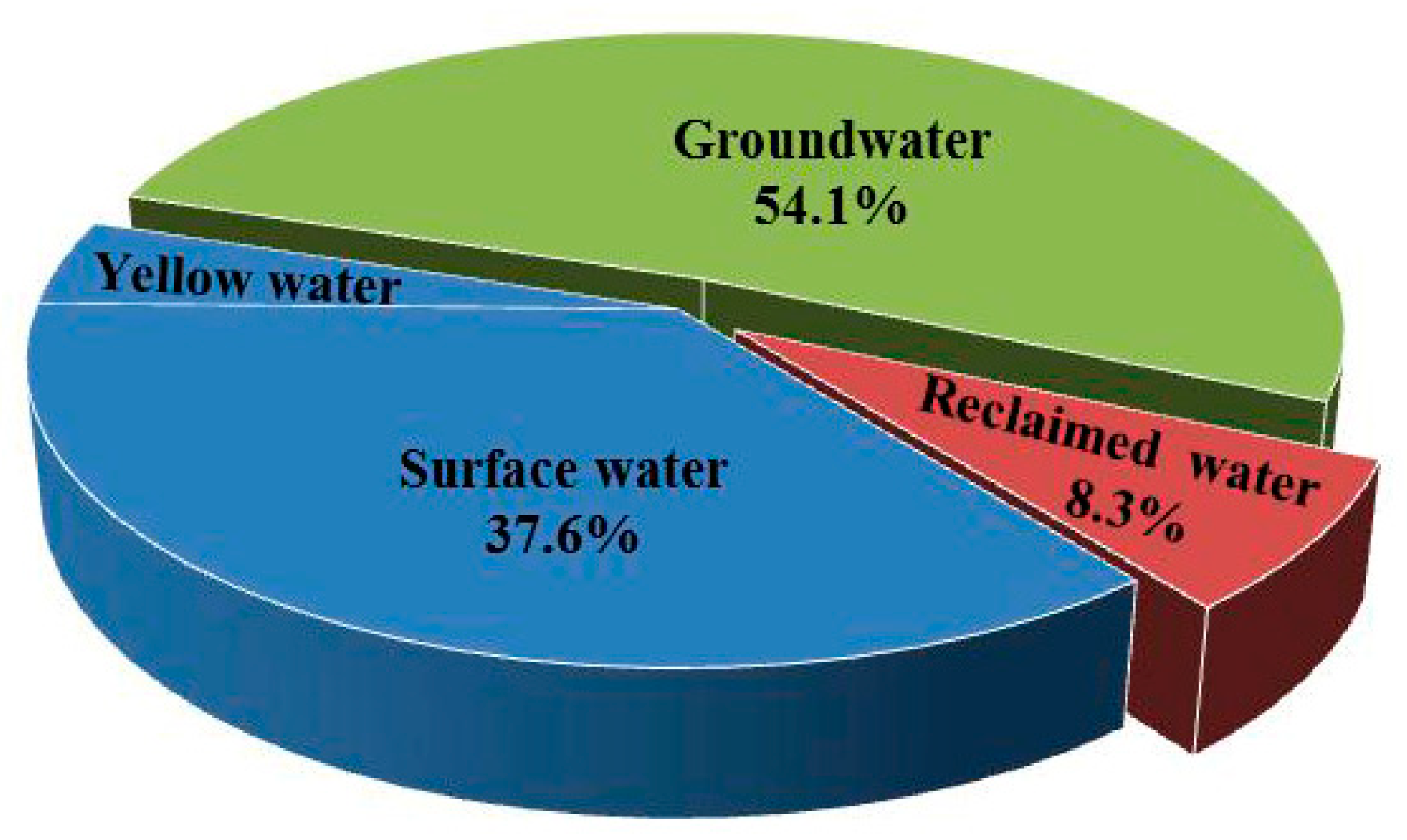
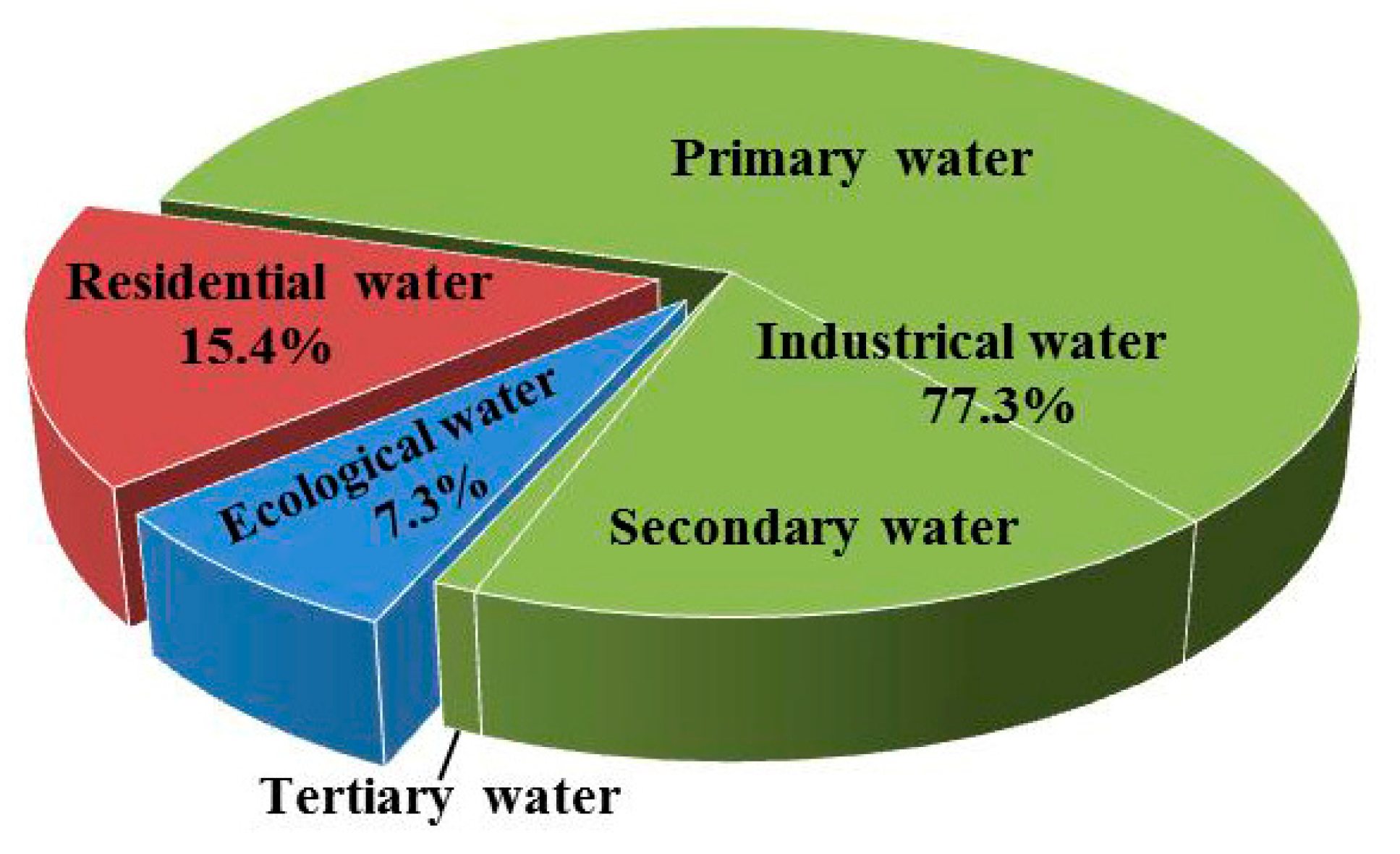
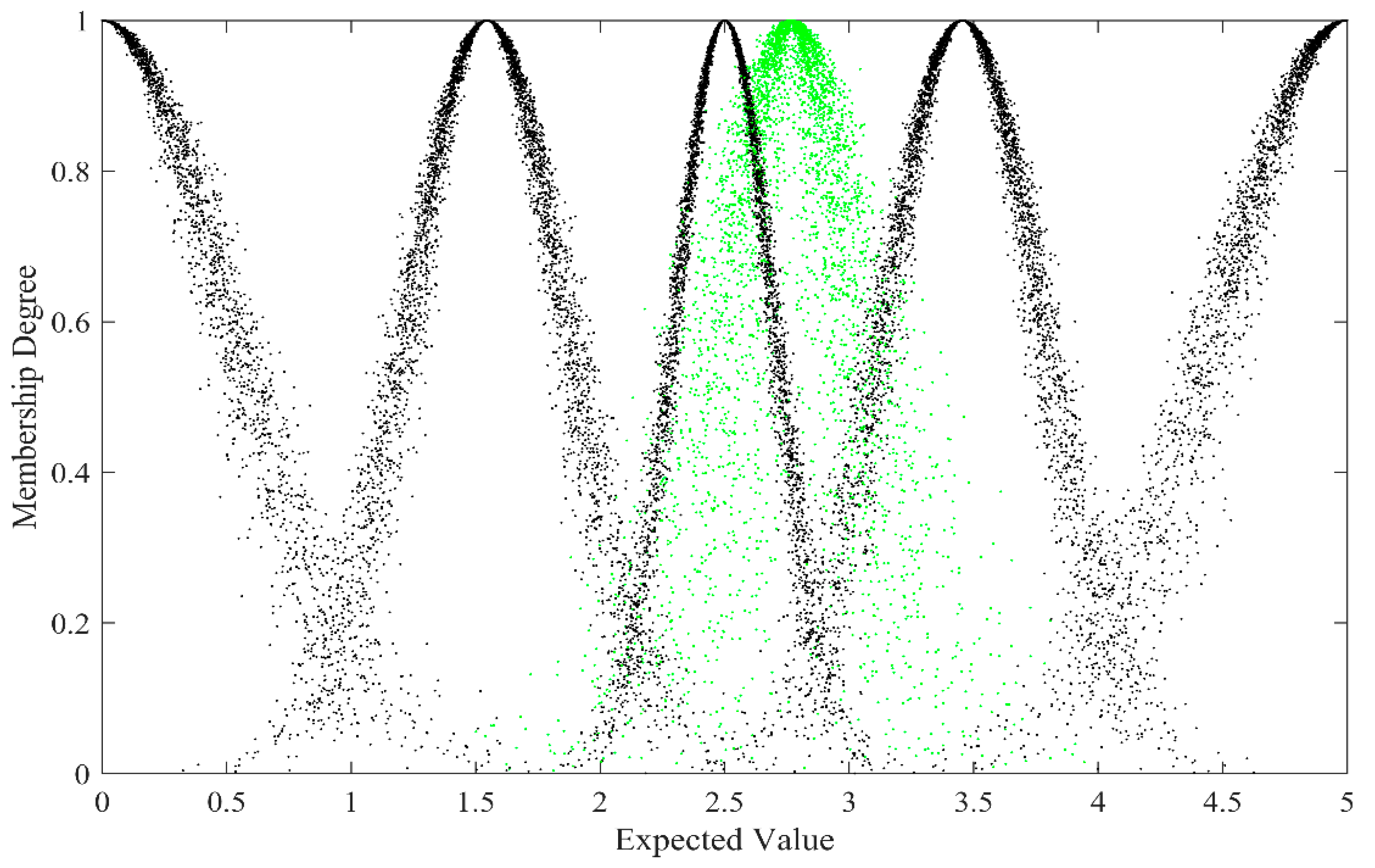
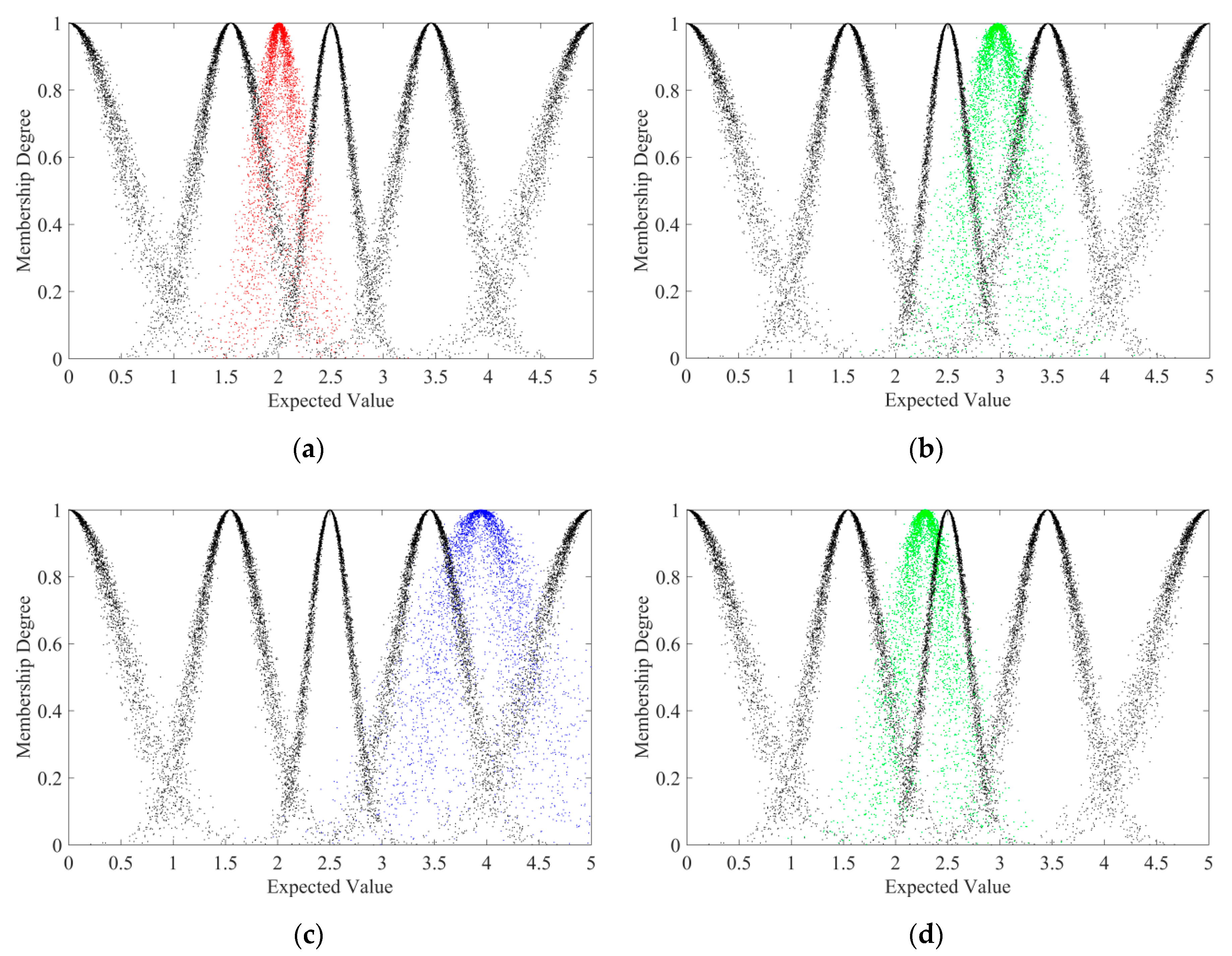
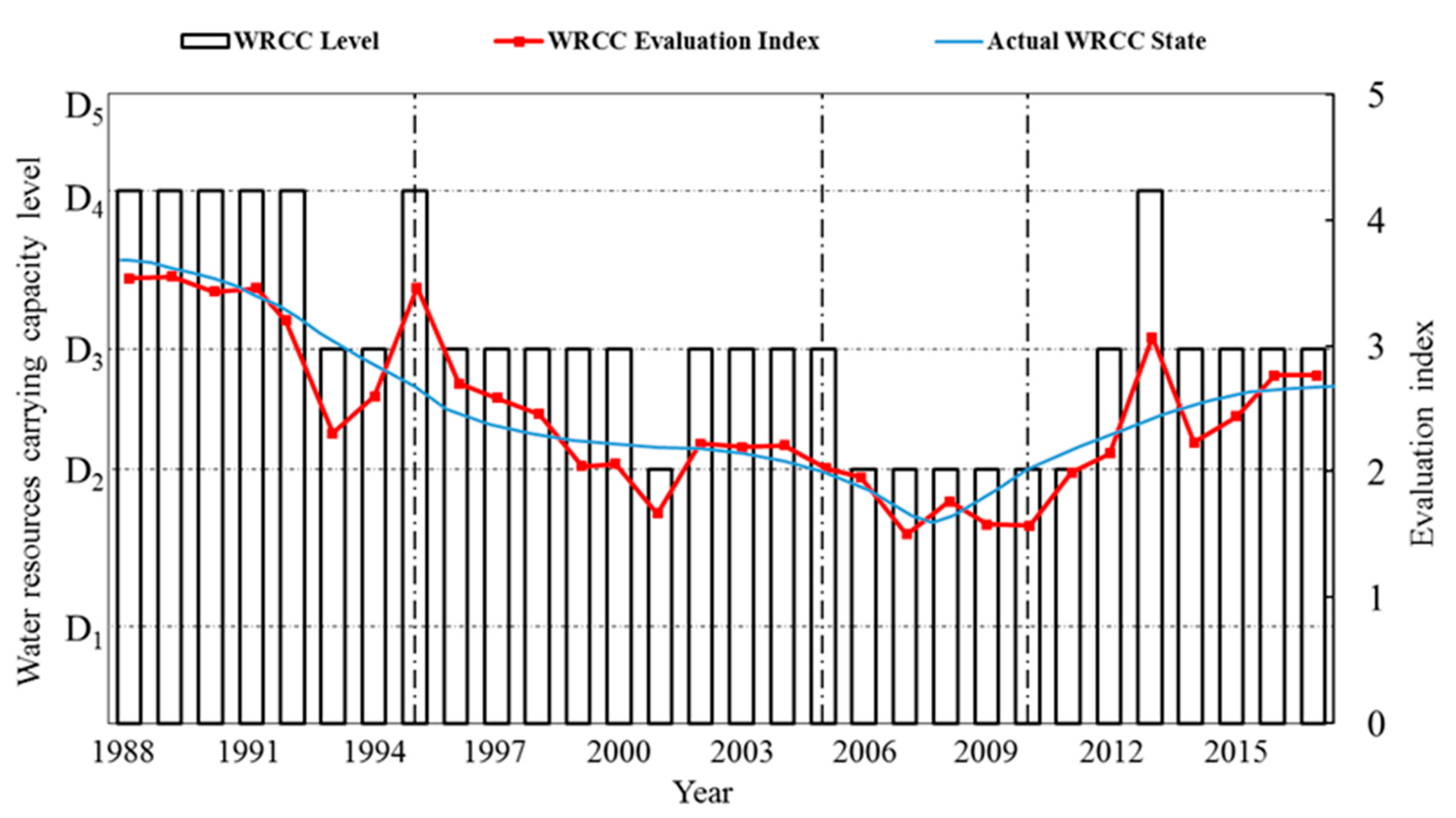
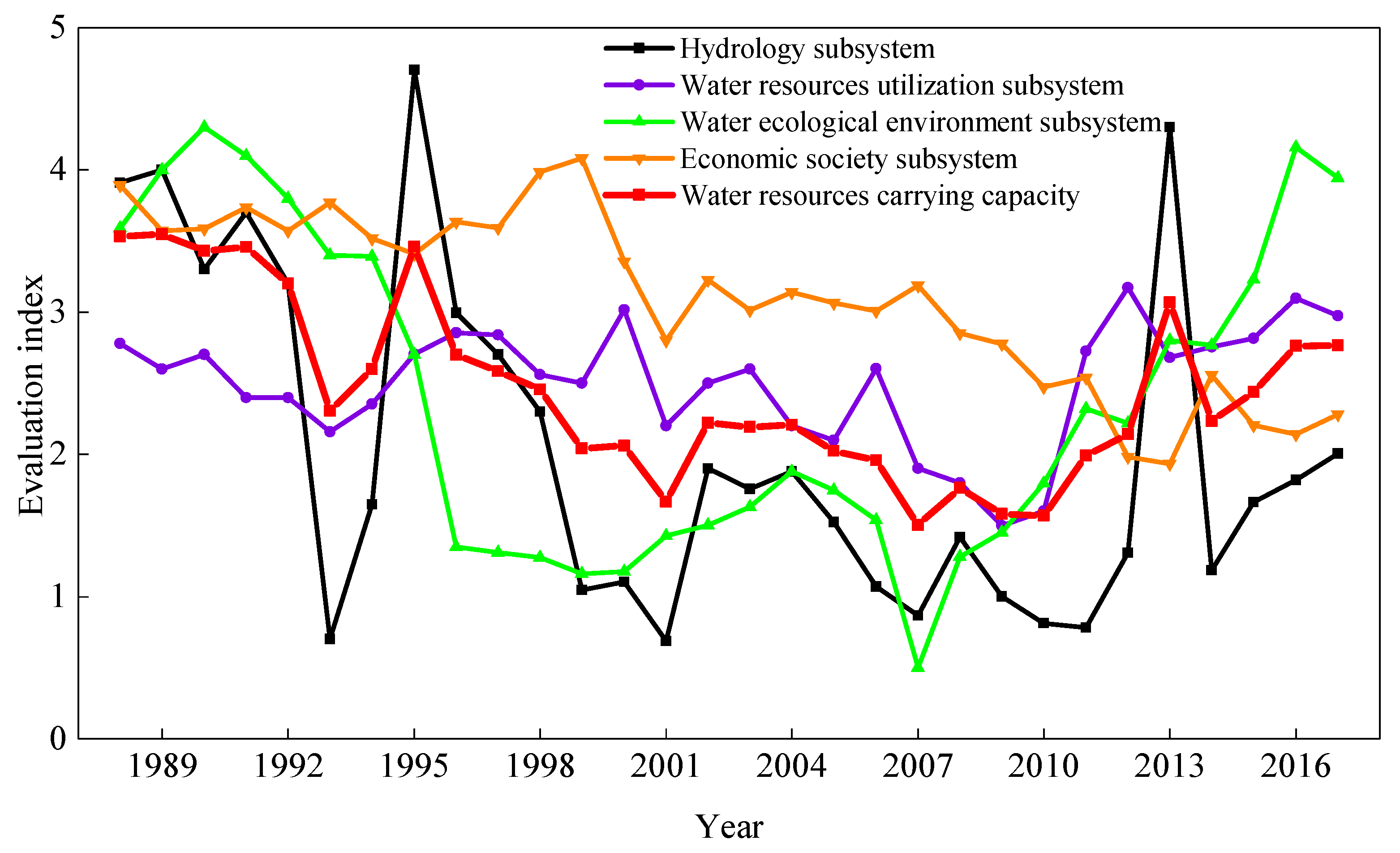
| Relative Importance | Degree | Saaty Scale | Cloud Scale |
|---|---|---|---|
| i is more important than j | Extreme | 9 | (9,0.17,0.05) |
| Strong | 7 | (7,0.17,0.05) | |
| Obvious | 5 | (5,0.17,0.05) | |
| A little | 3 | (3,0.17,0.05) | |
| i is as important as j | Equal | 1 | (1,0,0) |
| j is more important than i | A little | 1/3 | (1/3,0.17/9,0.05/9) |
| Obvious | 1/5 | (1/5,0.17/25,0.05/25) | |
| Strong | 1/7 | (1/7,0.17/49,0.05/49) | |
| Extreme | 1/9 | (1/9,0.17/81,0.05/81) | |
| i is more important than j, and the importance is between the two integers | 2, 4, 6, 8 | (2,0.17,0.05) | |
| j is more important than i, and the importance is between the two reciprocals of integers | 1/2, 1/4, 1/6, 1/8 | (1/2,0.17/4,0.05/4) | |
| Order | 1 | 2 | 3 | 4 | 5 | 6 | 7 | 8 | 9 | 10 | 11 | 12 | 13 | 14 | 15 |
| RI | 0 | 0 | 0.52 | 0.89 | 1.12 | 1.26 | 1.36 | 1.41 | 1.46 | 1.49 | 1.52 | 1.54 | 1.56 | 1.58 | 1.59 |
| Order | 16 | 17 | 18 | 19 | 20 | 21 | 22 | 23 | 24 | 25 | 26 | 27 | 28 | 29 | 30 |
| RI | 1.5943 | 1.6064 | 1.6133 | 1.6207 | 1.6292 | 1.6385 | 1.6403 | 1.6462 | 1.6497 | 1.6556 | 1.6587 | 1.6631 | 1.667 | 1.6693 | 1.6724 |
| Subsystem | D1 | D2 | D3 | D4 | D5 |
|---|---|---|---|---|---|
| Hydrology (+) | (0,0.515,0.065) | (1.545,0.318,0.04) | (2.5,0.2,0.02) | (3.455,0.318,0.04) | (5,0.515,0.065) |
| Water resources utilization (+) | (0,0.515,0.065) | (1.545,0.318,0.04) | (2.5,0.2,0.02) | (3.455,0.318,0.04) | (5,0.515,0.065) |
| Water ecological environment (+) | (0,0.515,0.065) | (1.545,0.318,0.04) | (2.5,0.2,0.02) | (3.455,0.318,0.04) | (5,0.515,0.065) |
| Economy and society (−) | (5,0.515,0.065) | (3.455,0.318,0.04) | (2.5,0.2,0.02) | (1.545,0.318,0.04) | (0,0.515,0.065) |
| Target Layer | System Layer | Indicator Layer | Calculation Formula | Significance |
|---|---|---|---|---|
| Evaluation of WRCC | Hydrology (+) | Precipitation in flood season (+) | Measured data | Reflect regional precipitation during the flood season |
| Runoff depth (+) | Annual runoff/Area | Reflects water depth evenly distributed over the area | ||
| Water resources per capita (+) | Total water resources/Total population | Reflecting the abundance, shortage, and potential of regional water resources | ||
| Water resources per unit area (+) | Total water resources/Area | Reflects water resources per unit area | ||
| Water production coefficient (+) | Total water resources/Precipitation | Reflects precipitation capacity in the research area | ||
| Drought Index (−) | Evaporation/Precipitation | Reflect the degree of regional drought | ||
| Water resources utilization (+) | Water consumption per capita (−) | Total water use/Total population | Reflect per capita water use | |
| Water supply modulus (−) | Water supply/Area | Reflecting water use per unit area | ||
| Development and utilization of surface water resources (−) | Surface water supply/Surface water availability | Reflect the degree of exploitation and utilization of surface water resources | ||
| Average water consumption per hectare of farmland irrigation (−) | Farmland irrigation water consumption/Irrigated area | Reflecting water use efficiency of agricultural | ||
| Proportion of groundwater use (−) | Groundwater consumption/Total water consumption | Reflect the proportion of groundwater use | ||
| Groundwater exploitation efficient (−) | Actual groundwater exploitation/Exploitable groundwater | Reflect the status and potential of groundwater exploitation | ||
| Water consumption per ten-thousand CNY (USD 1426) of industrial added value (−) | Industrial water consumption/Industrial added value | Reflect industrial water utilization levels | ||
| Urban domestic water quota (−) | Urban water consumption/Urban population/days | Reflect the level of urban residents’ domestic water use | ||
| Rural domestic water quota (−) | Rural water consumption/Rural population/days | Reflect the level of rural residents’ domestic water use | ||
| Water consumption per ten-thousand CNY (USD 1426) of GDP (−) | Total water consumption/GDP | Reflect the overall economic water situation in the region | ||
| Proportion of water used in the tertiary industry (+) | Tertiary industry water consumption/Total water consumption | Reflect the proportion of water used in the tertiary industry | ||
| Water ecological environment (+) | Ecological environment water use rate (+) | Ecological and environmental water consumption/Total water resources | Reflect ecosystem needs for water | |
| Wastewater discharge per ten-thousand CNY (USD 1426) output value (−) | Wastewater discharge/GDP | Reflecting the status of wastewater discharge | ||
| Wastewater utilization rate (+) | Wastewater utilization/Wastewater discharge | Reflecting wastewater utilization capacity | ||
| Dilution ratio (−) | Wastewater discharge/Surface runoff | Reflect the surface water pollution status and dilution ability | ||
| Surface water quality index (+) | Concentration percentage value of the indicators in the corresponding grade | Reflect the quality of surface water environment | ||
| Economy and society (−) | Population density (+) | Total population/Area | Reflect regional population scale | |
| GDP per capita (+) | GDP/Total population | Reflect the overall economic level of the region | ||
| Urbanization rate (+) | Urban population/Total population | Reflect the scale of regional urban population | ||
| Tertiary industry ratio (+) | Added value of tertiary industry/GDP | Reflect the status of regional tertiary industry structure | ||
| Annual GDP growth rate (+) | (GDP of the current year-GDP of the previous year)/GDP of the previous year | Reflect the overall economic development capacity of the region |
| Indicator | Unit | Value in 2017 | The Maximum Value | The Minimum Value | D1 | D2 | D3 | D4 | D5 |
|---|---|---|---|---|---|---|---|---|---|
| Precipitation in flood season | mm | 307.3 | 520 | 180 | <248 | (248, 316) | (316, 384) | (384, 452) | ≥452 |
| Runoff depth | mm | 34 | 70 | 15 | <26 | (26, 37) | (37, 48) | (48, 59) | ≥59 |
| Water resources per capita | m3/person | 277.2 | 480 | 180 | <240 | (240, 300) | (300, 360) | (360, 420) | ≥420 |
| Water resources per unit area | 104 m3/km2 | 6.8 | 10 | 4 | <5.2 | (5.2, 6.4) | (6.4, 7.6) | (7.6, 8.8) | ≥8.8 |
| Water production coefficient | - | 0.2 | 0.25 | 0.1 | <0.13 | (0.13, 0.16) | (0.16, 0.19) | (0.19, 0.22) | ≥0.22 |
| Drought Index | - | 2.4 | 4.5 | 1.5 | ≥3.9 | (3.3, 3.9) | (2.7, 3.3) | (2.1, 2.7) | <2.1 |
| Water consumption per capita | m3/person | 178.7 | 240 | 120 | ≥216 | (192, 216) | (168, 192) | (144, 168) | <144 |
| Water supply modulus | 104 m3/km2 | 4.4 | 5.5 | 2.5 | ≥4.9 | (4.3, 4.9) | (3.7, 4.3) | (3.1, 3.7) | <3.1 |
| Development and utilization of surface water resources | % | 67 | 90 | 20 | ≥76 | (62, 76) | (48, 62) | (34, 48) | <34 |
| Average water consumption per hectare of farmland irrigation | m3/hm2 | 161.2 | 350 | 150 | ≥310 | (270, 310) | (230, 270) | (190, 230) | <190 |
| Proportion of groundwater use | % | 54.1 | 75 | 45 | ≥69 | (63, 69) | (57, 63) | (51, 57) | <51 |
| Groundwater exploitation efficient | - | 0.8 | 1 | 0.4 | ≧0.88 | (0.76, 0.88) | (0.64, 0.76) | (0.52, 0.64) | <0.52 |
| Water consumption per ten-thousand CNY (USD 1426) of industrial added value | m3/104 CNY | 54.8 | 380 | 50 | ≥314 | (248, 314) | (182, 248) | (116, 182) | <116 |
| Urban domestic water quota | L/person.day | 82.8 | 140 | 70 | ≥126 | (112, 126) | (98, 112) | (84, 98) | <84 |
| Rural domestic water quota | L/person.day | 63.1 | 80 | 30 | ≥70 | (60, 70) | (50, 60) | (40, 50) | <40 |
| Water consumption per ten-thousand CNY (USD 1426) of GDP | m3/104 CNY | 52.5 | 220 | 40 | ≥184 | (148, 184) | (112, 148) | (76, 112) | <76 |
| Proportion of water used in the tertiary industry | % | 1.8 | 2 | 0.8 | <1.04 | (1.04, 1.28) | (1.28, 1.52) | (1.52, 1.76) | ≥1.76 |
| Ecological environment water use rate | % | 4.7 | 5 | 0.5 | <1.4 | (1.4, 2.3) | (2.3, 3.2) | (3.2, 4.1) | ≥4.1 |
| Wastewater discharge per ten-thousand CNY (USD 1426) output value | m3/104 CNY | 9.2 | 170 | 5 | ≥137 | (104, 137) | (71, 104) | (38, 71) | <38 |
| Wastewater utilization rate | % | 49.8 | 50 | 5 | <14 | (14, 23) | (23, 32) | (32, 41) | ≥41 |
| Dilution ratio | % | 15.8 | 30 | 5 | ≥25 | (20, 25) | (15, 20) | (10, 15) | <10 |
| Surface water quality index | - | 59 | 80 | 20 | <32 | (32, 44) | (44, 56) | (56, 68) | ≥68 |
| Population density | person/km2 | 244.2 | 300 | 190 | <212 | (212, 234) | (234, 256) | (256, 278) | ≥278 |
| GDP per capita | 104 CNY/person | 2.4 | 5 | 0.5 | <1.4 | (1.4, 2.3) | (2.3, 3.2) | (3.2, 4.1) | ≥4.1 |
| Urbanization rate | % | 62.9 | 65 | 20 | <29 | (29, 38) | (38, 47) | (47, 56) | ≥56 |
| Tertiary industry ratio | % | 47 | 50 | 20 | <26 | (26, 32) | (32, 38) | (38, 44) | ≥44 |
| Annual GDP growth rate | % | 4.8 | 10 | 2 | <3.6 | (3.6, 5.2) | (5.2, 6.8) | (6.8, 8.4) | ≥8.4 |
| Subsystem | Hydrology | Water Resources Utilization | Water Ecological Environment | Economy and Society |
|---|---|---|---|---|
| 1 | (1,0,0) | (1.167,0.103,0.052) | (1.443,0.158,0.070) | (1.500,0.156,0.072) |
| 2 | (1,0,0) | (1.167,0.103,0.052) | (1.333,0.085,0.050) | |
| 3 | (1,0,0) | (1.333,0.085,0.050) | ||
| 4 | (1,0,0) |
| Indicator | Precipitation in Flood Season | Runoff Depth | Water Resources per Capita | Water Resources per Unit Area | Water Production Coefficient | Drought Index |
|---|---|---|---|---|---|---|
| 1 | (1,0,0) | (1.667,0.136,0.071) | (2.333,0.170,0.087) | (3.667,0.170,0.087) | (3.000,0.170,0.087) | (4.667,0.170,0.087) |
| 2 | (1,0,0) | (1.667,0.136,0.071) | (3.000,0.170,0.087) | (2.333,0.170,0.087) | (4.000,0.170,0.087) | |
| 3 | (1,0,0) | (2.333,0.170,0.087) | (1.667,0.136,0.071) | (3.333,0.170,0.087) | ||
| 4 | (1,0,0) | (0.600,0.024,0.018) | (2.000,0.170,0.087) | |||
| 5 | (1,0,0) | (2.667,0.170,0.087) | ||||
| 6 | (1,0,0) |
| Indicator | Water Consumption per Capita | Water Supply Modulus | Development and Utilization of Surface Water Resources | Average Water Consumption per Hectare of Farmland Irrigation | Proportion of Groundwater Use | Groundwater Exploitation Efficient | Water Consumption per ten-thousand CNY of Industrial Added Value | Urban Domestic Water Quota | Rural Domestic Water Quota | Water Consumption per ten-thousand CNY of GDP | Proportion of water Used in the Tertiary Industry |
|---|---|---|---|---|---|---|---|---|---|---|---|
| 1 | (1,0,0) | (2.167,0.160,0.072) | (0.750,0.009,0.013) | (1,0,0) | (3.333,0.170,0.087) | (0.750,0.009,0.013) | (1.444,0.158,0.071) | (3.667,0.170,0.087) | (5.667,0.170,0.087) | (1.444,0.158,0.071) | (4.667,0.170,0.087) |
| 2 | (1,0,0) | (0.400,0.291,0.050) | (0.462,0.255,0.051) | (2.333,0.170,0.087) | (0.400,0.291,0.050) | (0.500,0.043,0.022) | (2.667,0.170,0.087) | (4.667,0.170,0.087) | (0.500,0.043,0.022) | (3.667,0.170,0.087) | |
| 3 | (1,0,0) | (1.333,0.085,0.050) | (3.667,0.170,0.087) | (1,0,0) | (1.778,0.161,0.071) | (4.000,0.170,0.087) | (6.000,0.170,0.087) | (1.778,0.161,0.071) | (5.000,0.170,0.087) | ||
| 4 | (1,0,0) | (3.333,0.170,0.087) | (0.750,0.009,0.013) | (1.444,0.158,0.071) | (3.667,0.170,0.087) | (5.667,0.170,0.087) | (1.444,0.158,0.071) | (4.667,0.170,0.087) | |||
| 5 | (1,0,0) | (0.273,0.031,0.013) | (0.300,0.017,0.008) | (1.333,0.085,0.050) | (3.333,0.170,0.087) | (0.300,0.017,0.008) | (2.333,0.170,0.087) | ||||
| 6 | (1,0,0) | (1.778,0.161,0.071) | (4.000,0.170,0.087) | (6.000,0.170,0.087) | (1.778,0.161,0.071) | (5.000,0.170,0.087) | |||||
| 7 | (1,0,0) | (3.667,0.170,0.087) | (5.667,0.170,0.087) | (1,0,0) | (4.667,0.170,0.087) | ||||||
| 8 | (1,0,0) | (3.000,0.170,0.087) | (0.273,0.017,0.008) | (2.000,0.170,0.087) | |||||||
| 9 | (1,0,0) | (0.176,0.006,0.003) | (0.500,0.043,0.022) | ||||||||
| 10 | (1,0,0) | (4.667,0.170,0.087) | |||||||||
| 11 | (1,0,0) |
| Indicator | Ecological Environment Water Use Rate | Wastewater Discharge per Ten-Thousand CNY Output Value | Wastewater Utilization Rate | Dilution Ratio | Surface Water Quality Index |
|---|---|---|---|---|---|
| 1 | (1,0,0) | (2.667,0.170,0.087) | (3.000,0.170,0.087) | (2.000,0.142,0.071) | (0.667,0.191,0.053) |
| 2 | (1,0,0) | (1.333,0.085,0.050) | (0.600,0.024,0.018) | (0.333,0.019,0.010) | |
| 3 | (1,0,0) | (0.500,0.043,0.022) | (0.300,0.017,0.008) | ||
| 4 | (1,0,0) | (0.429,0.038,0.019) | |||
| 5 | (1,0,0) |
| Indicator | Population Density | GDP per Capita | Urbanization Rate | Tertiary Industry Ratio | Annual GDP Growth Rate |
|---|---|---|---|---|---|
| 1 | (1,0,0) | (0.857,0.140,0.052) | (2.000,0.170,0.087) | (3.000,0.170,0.087) | (2.000,0.142,0.071) |
| 2 | (1,0,0) | (2.000,0.142,0.071) | (3.000,0.170,0.087) | (2.000,0.170,0.087) | |
| 3 | (1,0,0) | (2.000,0.142,0.071) | (0.857,0.140,0.052) | ||
| 4 | (1,0,0) | (0.500,0.043,0.022) | |||
| 5 | (1,0,0) |
| Subsystem | Weight Cloud Eigenvalues | Indicator | Weight Cloud Eigenvalues |
|---|---|---|---|
| Hydrology | (0.310,0.285,0.305) | Precipitation in flood season | (0.336,0.339,0.336) |
| Runoff depth | (0.241,0.229,0.235) | ||
| Water resources per capita | (0.169,0.178,0.173) | ||
| Water resources per unit area | (0.083,0.081,0.082) | ||
| Water production coefficient | (0.118,0.124,0.122) | ||
| Drought Index | (0.053,0.050,0.051) | ||
| Water resources utilization | (0.264,0.250,0.262) | Water consumption per capita | (0.132,0.127,0.130) |
| Water supply modulus | (0.072,0.081,0.077) | ||
| Development and utilization of surface water resources | (0.160,0.152,0.157) | ||
| Average water consumption per hectare of farmland irrigation | (0.132,0.127,0.130) | ||
| Proportion of groundwater use | (0.043,0.042,0.043) | ||
| Groundwater exploitation efficient | (0.160,0.152,0.157) | ||
| Water consumption per ten-thousand CNY of industrial added value | (0.110,0.121,0.114) | ||
| Urban domestic water quota | (0.037,0.035,0.036) | ||
| Rural domestic water quota | (0.019,0.017,0.018) | ||
| Water consumption per ten-thousand CNY of GDP | (0.110,0.121,0.114) | ||
| Proportion of water used in the tertiary industry | (0.026,0.024,0.025) | ||
| Water ecological environment | (0.233,0.265,0.243) | Ecological environment water use rate | (0.280,0.311,0.292) |
| Wastewater discharge per ten-thousand CNY output value | (0.110,0.105,0.109) | ||
| Wastewater utilization rate | (0.091,0.086,0.088) | ||
| Dilution ratio | (0.163,0.157,0.163) | ||
| Surface water quality index | (0.356,0.341,0.349) | ||
| Economy and society | (0.193,0.200,0.190) | Population density | (0.289,0.299,0.293) |
| GDP per capita | (0.307,0.300,0.304) | ||
| Urbanization rate | (0.153,0.158,0.155) | ||
| Tertiary industry ratio | (0.089,0.085,0.086) | ||
| Annual GDP growth rate | (0.163,0.159,0.162) |
| Name of the Evaluation Index Cloud | Eigenvalues of the Cloud |
|---|---|
| Hydrology subsystem | (2.006,0.162,0.160) |
| Water resources utilization subsystem | (2.976,0.226,0.225) |
| Water ecological environment subsystem | (3.944,0.386,0.389) |
| Economy and society subsystem | (2.283,0.226,0.226) |
| Water resources carrying capacity | (2.767,0.250,0.245) |
Publisher’s Note: MDPI stays neutral with regard to jurisdictional claims in published maps and institutional affiliations. |
© 2020 by the authors. Licensee MDPI, Basel, Switzerland. This article is an open access article distributed under the terms and conditions of the Creative Commons Attribution (CC BY) license (http://creativecommons.org/licenses/by/4.0/).
Share and Cite
Ren, B.; Zhang, Q.; Ren, J.; Ye, S.; Yan, F. A Novel Hybrid Approach for Water Resources Carrying Capacity Assessment by Integrating Fuzzy Comprehensive Evaluation and Analytical Hierarchy Process Methods with the Cloud Model. Water 2020, 12, 3241. https://doi.org/10.3390/w12113241
Ren B, Zhang Q, Ren J, Ye S, Yan F. A Novel Hybrid Approach for Water Resources Carrying Capacity Assessment by Integrating Fuzzy Comprehensive Evaluation and Analytical Hierarchy Process Methods with the Cloud Model. Water. 2020; 12(11):3241. https://doi.org/10.3390/w12113241
Chicago/Turabian StyleRen, Bo, Qiuwen Zhang, Juanhui Ren, Song Ye, and Fei Yan. 2020. "A Novel Hybrid Approach for Water Resources Carrying Capacity Assessment by Integrating Fuzzy Comprehensive Evaluation and Analytical Hierarchy Process Methods with the Cloud Model" Water 12, no. 11: 3241. https://doi.org/10.3390/w12113241
APA StyleRen, B., Zhang, Q., Ren, J., Ye, S., & Yan, F. (2020). A Novel Hybrid Approach for Water Resources Carrying Capacity Assessment by Integrating Fuzzy Comprehensive Evaluation and Analytical Hierarchy Process Methods with the Cloud Model. Water, 12(11), 3241. https://doi.org/10.3390/w12113241




